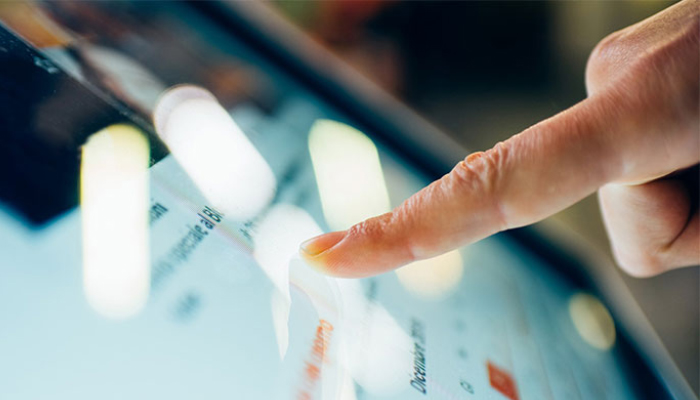The Coming Demand For Touch Screens In Electronics Industry
By Steven J. Goodman, User Interface & Cable Assembly Product Manager
Epec Engineered Technologies
Due to increasing global competition and demand for innovative new products on a more frequent basis than ever before, industry is being forced to move at a faster pace than ever before. In addition, customers, whether in a B2B or B2C market, demand customized products, short lead times, and higher quality. For several years during the transition, companies relied on cost-cutting to stay competitive with low-wage regions, but cost-cutting is not a sustainable long-term strategy.
As a result, companies in most industries are searching for ways to retain and grow market share while staying profitable. With margins at the breaking point, companies are looking at alternatives. Technology and ingenuity are both necessary to navigate the changing industrial landscape. Touch screens are one of the technology tools that can help by increasing worker productivity, improving product quality, and making operations more efficient.

Forces For Change
Most companies today sell to customers all over the world, which means competition is no longer confined to just the company across town or in the next state. New competition arises daily in every corner of the world. These competitors start with a clean sheet of paper—no old equipment, outdated processes, or expensive wage and benefits structures. As a result, these companies can focus on creating lean, streamlined processes that enable them to meet customer expectations for price, delivery, and quality easily, even for customized products.
As established companies work to hone their competitiveness, the aging workforce becomes a complicating factor in this endeavor. Pew Research reports that 10,000 baby boomers turn 65 each day, and that pace will continue through 2030. While this helps to relieve some of the wage pressures from the higher salaries that experienced workers command, it also means that industries are facing a constant drain of critical knowledge and skills. They need to capture and disseminate this knowledge before it is lost.
Focus On Metrics And Process Improvement
Long-established companies have countered these forces by adopting business process modeling and lean or Six Sigma to help them level the quality and delivery time playing field. Most companies today focus on a few core metrics to help them monitor process performance and quality in near-real time. They use continuous improvement techniques such as Kaizen and DMAIC (Define, Measure, Analyze, Improve, Control) to ensure they make products of consistent quality at a predictable and repeatable pace.
Industrial metrics are only useful when they are readily available in near real time to enable workers to take corrective actions as soon as a process begins to go astray or to update production status.
In certain industries, particularly those heavily process dependent such as chemicals, pharmaceuticals and oil and gas, PLCs or sensors have been used to provide information directly from equipment to Supervisory Control and Data Acquisition (SCADA) or manufacturing execution systems (MES) for later analysis. However, despite collecting data in real time, the technology for analysis frequently couldn’t keep up, so data didn’t become actionable information until it was too late to take meaningful action.
IoT And Big Data
The Internet of Things, or IoT, is the term used to refer to the new generation of connected devices and equipment. More devices than ever before are connected and collecting data in real time. In fact, Gartner estimates that 26 billion devices will be connected by 2020. Connected devices range from home heating and cooling equipment and thermostats (think Nest or Lyric) to nuclear reactors, high-voltage power plants, and a vast array of industrial machinery and equipment. With all those devices monitoring multiple parameters in real time, the volume of data is staggering.
Fortunately, analytics technology has advanced as well. Big Data analytics engines such as Hadoop or SAP’s Hana in-memory database can analyze vast quantities of data very quick. Unlike traditional business intelligence and analytics solutions, this new generation does not require information to be in a specific format, nor do they require predefined queries and reports to be useful.
Big Data functions with a vast array of data, including traditional structured or formatted data, as well as unstructured data such as documents, newsfeeds, or data streamed from sensors. Big Data tools sift through disparate data from multiple sources at a high speed, looking for trends and anomalies and presenting their findings in a visual format that is easy for users to quickly grasp. Thus, Big Data is an ideal solution for industrial companies looking for a better way to monitor process quality and performance.

How Touch Screens Address The Industrial Challenges
As industry becomes even more data driven, companies need to find ways to make data more accessible to workers in every area, including the plant floor. Touch screens are the ideal solution because they are inexpensive, easy to operate, rugged, and mobile. The large screen sizes available mean that a touch screen can display more information than traditional methods, such as bar code readers. The use of dashboards enables users to see process status at a glance without having to check a mechanical cockpit with multiple dials and gauges.
The data visualization makes it easy for people to see and act on exception information, even allowing for the diminished vision of older workers. Data visualization on industrial touch screens overcomes language barriers, skill sets, and environmental conditions such as low light.
Touch screens can be mounted directly on the equipment they are monitoring, in any nearby area, or even in another location altogether in the case of dangerous or unhealthy industrial environments, making them ideal for any industrial facility.
Touch screens are versatile as well. By selecting a resistive touch screen, users will be able to interact with the device using a stylus or while wearing gloves, which may be an important consideration in certain conditions. In low-light situations, you may prefer an infrared touch panel. If graphics are a top priority, a high-quality surface capacitive screen may be the best choice.
If the screen must be visible at a distance, the large sizes available in infrared screens may be very important. The lifecycle of the screen also varies by touch type, as does its resistance to environmental conditions such as grit, solvents, or water. You can find out more information about the characteristics of the various types of touch screens by reading our technical article, and of course, our engineering team will be happy to work with you to identify the best option for your situation.

The Case For Touch Screens
Touch screens have so many applications in the industry that it’s hard to understand how companies functioned without them in the past. Here are a few examples:
- CNC machine setup: Production lines and manufacturing equipment are often controlled by computers (CNC). Rather than use tooling or manual settings, these units use computer programs to define operating specifications. Using a touch screen to load the instructions speeds up changeovers and reduces downtime. A touch screen provides an easier interface than a traditional screen and often shields the user from the operating system complexities.
- Production reporting: Industrial companies need to monitor production throughput on a regular basis to ensure they stay on schedule, but to date there hasn’t been an easy and accurate way to capture the required information. RFID sensors are expensive and unreliable. Bar codes are cumbersome and complex. Entering production status on a touch screen at the point of the operation is easy, fast and accurate. It transcends language barriers and is simpler than any other available method. The increased accuracy helps ensure efficient production scheduling and can help improve customer satisfaction by providing more accurate delivery information.
- Recording quality results: When transcribing complex measurements or other quality standards, accuracy is paramount. Using a touchscreen helps improve accuracy because it is easier to enter information on the screen than on a keyboard, especially in low-light situations or while wearing gloves.
- Mechanical controls: Industrial equipment often has several mechanical controls and switches, but many companies are replacing the complex array with a simple touch screen. This helps to eliminate operator errors, and the on-screen steps help walk workers through the process without the need for extensive training or process aids. In addition, the screens provide immediate feedback about process issues, and if the process changes, the change shows up right away on the screen.
There is little doubt that touch screens are changing the face of industry. In fact, IHS Research predicts that shipments of industrial touch panels and sensors will reach 2.5 billion by 2019, a compound annual growth rate of more than 4 percent. Touch screens are adaptable to almost any industrial environment, including wet, low light, dirty, or dangerous locations that require workers to wear protective gear such as gloves and goggles.
Using a touch screen interface enables vision-impaired or older workers to continue to perform effectively because screens are large, bright, easy to read, and they present data in a simple-to-use format. Workers who are comfortable in the digital world enjoy working with touch screens more than with paper reporting or mechanical controls, which makes touch screens the perfect medium to help companies retain older workers longer, helping to bridge the potential skills gap they might otherwise face.
Touch screens adapt easily to multiple languages, so workers can interact in their native language, increasing accuracy and compliance. This helps companies with a diverse or global workforce meet the needs of every worker.
Summary
With their easy-to-understand data visualization, touch screens help companies react quickly to potential production or quality problems. Workers can see immediately when a problem occurs and stop the line or take the appropriate corrective action. This helps ensure efficient production, reduces quality problems, increases throughput, and helps with job satisfaction because workers feel more empowered and knowledgeable.
Companies can monitor performance toward goals and ensure that quality and costs are on target, helping to ensure healthy margins and enabling them to compete better in global markets. Touch screens are an essential part of the industrial future. They provide important benefits to every industry. Touch screens increase efficiency, help ensure compliance, make it easier to monitor performance, adapt quickly to changes, are rugged and are versatile for a variety of conditions and use cases, are highly visible and cost-effective. Consider incorporating touch screens in your industrial processes so your company can begin enjoying these benefits.
Looking To Update An Existing Keypad Design To A Touch Screen?
Our team of engineers can help you design and manufacture touch screen interfaces into both a new design and existing product update.
Request a Quote Request Design Support

